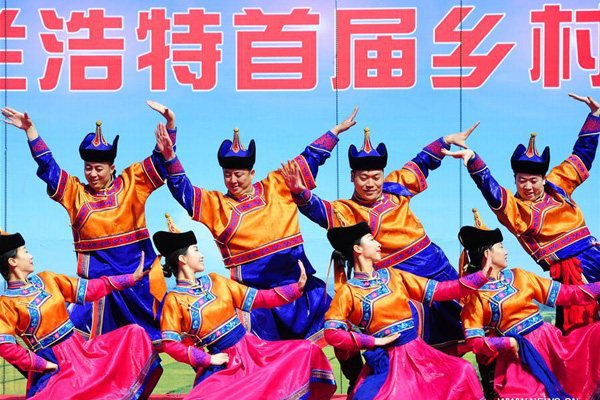
Photo taken on April 28, 2017 shows the scenery of a gala held in Ulanhot City, North China’s Inner Mongolia autonomous region. Inner Mongolia autonomous region, the first province-level autonomous region established in China, celebrated its 70th birthday on May 1, 2017.[Photo/Xinhua]
HOHHOT — Inner Mongolia, the first province-level autonomous region established in China, celebrated its 70th birthday with a gala on May 1, highlighting the country’s successful practice of regional ethnic autonomy.
More than 1,000 people dressed in traditional Mongolian costumes performed dances and Mongolian music on Wuyi Square in Ulanhot city in the east of the region, where the regional autonomous government was founded on May 1, 1947.
“The 70th anniversary is a big event. Our whole family come here to watch the gala,” said Zhao Hongfu, 82, a Mongolian in Ulanhot.
Talking about the changes, Zhao said his family lived in a small clay-made house while now they live in a building with stories.
“In the past, there might be sort of discrimination between different ethnic groups. But now, people from Han, Mongolian and other ethnic groups live in the same building,” he added.
Zhao’s remarks on the huge progress were echoed by others. Li Kun, 91, recalled his poor life when the autonomous region was founded.
“At that time, ordinary people ate steamed cornbread, used kerosene lamps and wore shabby clothes,” he said. “Today, the life is very different.”
The system of regional autonomy for ethnic minorities is a basic political system in China.
Besides Inner Mongolia, the other four areas are Xinjiang Uygur, Guangxi Zhuang, Ningxia Hui and Tibet autonomous regions.
The first National People’s Congress that convened in 1954 included the system of regional autonomy for ethnic minorities in the Constitution of the People’s Republic of China, and the regional ethnic autonomy law was put into effect in 1984.
“The regional ethnic autonomy is the fundamental guarantee of rapid development of Inner Mongolia,” said Hobsgaalt, a Mongolian and head of the Bairin Right Banner government in the region.
The percentage of officials from ethnic minorities is an important reflection of autonomy rights.
In Inner Mongolia, officials from ethnic minority groups account for 33 percent of the total, higher than the proportion of their population.
Zhou Jinghong, an ethnic policy researcher with the Chinese Academy of Social Sciences, said that a successful experience of Inner Mongolia was the protection and prosperity of the traditional culture of the ethnic Mongolian group.
“In recent years, a large number of traditional Mongolian cultural heritage items have been inscribed on protection lists at different levels,” she said.
“We are in an era of cultural prosperity. Since China’s reform and opening-up, the environment has provided favorable conditions for the development of Mongolian culture,” said Baljinima, a retired Mongolian reporter in Hohhot, the regional capital.
He and his wife Zhang Jixia, an ethnic Han, have visited 50 countries and collected 12,000 Genghis Khan-related books in different languages, for research.
Over the past three decades, China has strengthened research in the history and culture of Mongolians, and a group of bilingual Chinese-Mongolian scholars have emerged, according to Gombzarb, an influential Mongolian poet and chairman of the Inner Mongolia Federation of Literary and Art Circles.
Great changes have taken place on the prairie of Inner Mongolia since 1947. Most herders settled down and now live a better life.
Burenjargal, a herder on the outskirts of Xilinhot city, moved to a new house with a TV set, tap water, a flush toilet and a gas stove three years ago.
He has 60 horses and 10 cattle on his grassland. Last year, his revenue from selling horses and mare’s milk, and tourism, reached 200,000 yuan ($29,000).
With government subsidy, herders raise livestock in sustainable fashion to protect the grasslands.
Inner Mongolia covers an area of 1.18 million sq km, about 12 percent of the country’s land area. The Mongolian population is 4.6 million, nearly one-fifth of the region’s total.
Over the past 70 years, the region’s economy has expanded from 537 million yuan to 1.86 trillion yuan. The per capita GDP of the region exceeds $10,000.
China’s ethnic policy features equality, unity, regional ethnic autonomy and common prosperity for all ethnic groups.
Ao Junde, a regional ethnic autonomy law expert, said China had taken the lead in protecting the rights of ethnic minorities with a comprehensive set of theory, policy, system and law.
“China’s regional ethnic autonomy has its own socialist characteristics, but it is of important reference value for many countries still plagued by ethnic issues today,” Zhou said.
